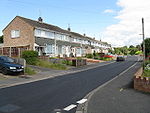Rushwick Halt railway station
Beeching closures in EnglandDisused railway stations in WorcestershireFormer Great Western Railway stationsPages with no open date in Infobox stationRailway stations in Great Britain closed in 1965 ... and 2 more
Railway stations in Great Britain opened in 1924West Midlands (region) railway station stubs

Rushwick Halt railway station was a station in Rushwick, Worcestershire, England. The station was opened on 31 March 1924 and closed on 5 April 1965.
Excerpt from the Wikipedia article Rushwick Halt railway station (License: CC BY-SA 3.0, Authors, Images).Rushwick Halt railway station
Bransford Road, Worcester, England Dines Green
Geographical coordinates (GPS) Address Nearby Places Show on map
Geographical coordinates (GPS)
| Latitude | Longitude |
|---|---|
| N 52.1829 ° | E -2.2602 ° |
Address
Bransford Road
Bransford Road
WR2 5SQ Worcester, England, Dines Green
England, United Kingdom
Open on Google Maps








